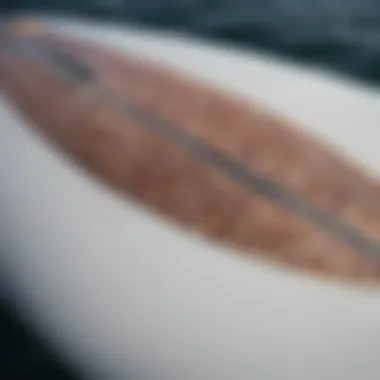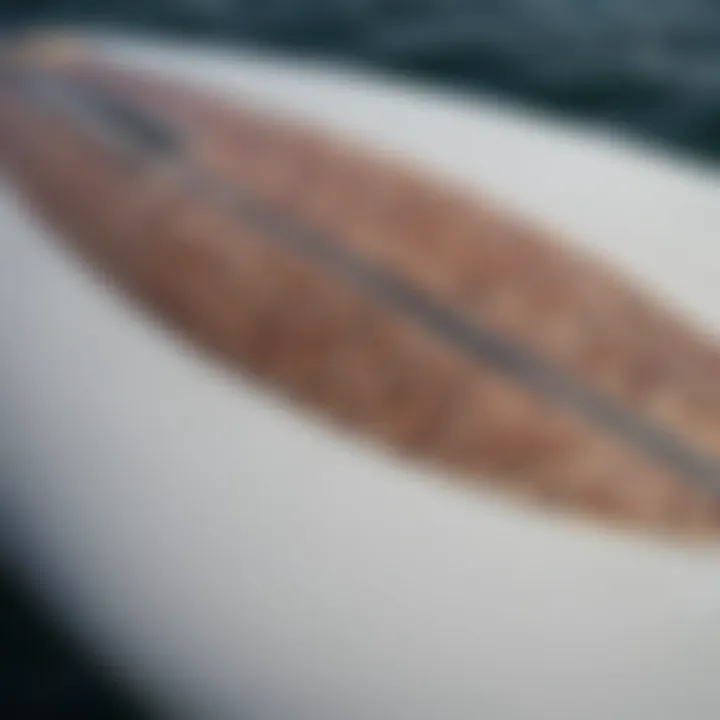Exploring Hydrofoil Surfboards: Design and Function


Intro
In the realms of watersports, hydrofoil surfboarding stands out not just for its sleek aesthetic but also for the thrilling experience it offers. This fascinating sport takes traditional surfing and elevates it—literally. Through a unique combination of engineering and physical principles, hydrofoil boards allow riders to glide above the water's surface while harnessing the power of waves and wind. But what makes these boards tick? Understanding the mechanics behind hydrofoil surfboards can offer valuable insights for both budding surfers and seasoned enthusiasts.
The mechanics of hydrofoil surfboards hinge on the concept of lift generation. As the board moves through the water, its hydrofoil—often a wing-like structure—creates lift, allowing the rider to break free from the water's surface. This article attempts to unravel these fundamentals while exploring the intricacies of hydrofoil construction, board design, and personal experiences. It serves as a guide for enthusiasts, instructors, and anyone curious about this innovative form of surfing.
So, whether you are looking to enhance your skills or simply understand the engineering marvel behind hydrofoil surfboards, you’re in the right place. Let’s dive deeper into the techniques required for mastering this sport.
Prolusion to Hydrofoil Surfboards
Hydrofoil surfboards, once a niche concept primarily embraced by a handful of enthusiasts, have surged into mainstream watersports. The importance of comprehending the intricacies of these boards cannot be overstated, especially for those looking to expand their repertoire on the water. Hydrofoil surfboards fundamentally alter the way we interact with waves. They let riders glide above the surface, offering a different experience compared to traditional surfboards.
When you think about hydrofoiling, several vital elements come into play. First and foremost, the mechanics behind their lift and stability are crucial. Understanding how these boards work gives riders the confidence they need to tackle varying conditions. Additionally, the performance advantages, such as reduced drag and increased speed, make hydrofoil boards an attractive alternative. Moreover, as anyone who’s ever caught a wave can attest, each watercraft has its learning curve, making knowledge of suitable training and practice techniques invaluable.
Finally, for those coaching others or marketing products related to hydrophilic surfing, being familiar with this technology. This can enhance their credibility in a rapidly growing market. It is not just about riding the waves; it's about understanding the engineering that allows for smoother, faster, and more exhilarating rides.
Definition and Overview
Hydrofoil surfboards are designed with a unique mechanism featuring a submerged wing or foil beneath the board. This foil generates lift when the board is in motion, allowing it to rise above the water’s surface. The result is a ride that feels as though it floats, minimizing contact with the water and reducing drag. It's like the sensation of flying over the ocean with every stroke of the paddle, an experience that can only be described as liberating.
This advancement has captivated a diverse array of water enthusiasts, from surfers to kiteboarders. As you ride, the stability offered by the hydrofoil lets you maintain speed even in choppy waters. This builds confidence and assists those looking to push their boundaries.
History and Evolution
The origins of hydrofoil technology can be traced back to the early 1900s, with pioneers experimenting with various designs in pursuit of greater speeds on water. Fast forward to the late 20th century, and hydrofoils began to make their mark in competitive sailing and motor racing, proving their efficacy in performance.
With surfing evolving in tandem with advances in technology, hydrofoils made their first appearances in surfboards around the year 2000. Although they were met with skepticism at first, their advantages became too significant to ignore. Just look at the trajectory—what was once an exotic innovation has blossomed into a favored tool for wave riders, supported by an ever-growing community of enthusiasts sharing techniques, tips, and experiences across various platforms.
As hydrofoil surfboards continue to evolve, innovations in materials and design are streamlining performance. The advent of lighter materials, like carbon fiber and advanced polymers, is paving the way for more agile boards, further enhancing the riding experience. With this rich history, one can appreciate not just how far hydrofoils have come but also their potential for future developments in watersports.
The Science of Hydrofoils
Understanding the science behind hydrofoils is crucial for grasping how these innovative boards revolutionize the surfing experience. At the heart of a hydrofoil lies the intricate dance between lift and drag, which dictates how the board interacts with the water beneath it. This section delves into the fundamental principles that govern hydrofoil technology, bringing to light the benefits of its design and the important considerations users should keep in mind.
Principles of Lift and Drag
The concepts of lift and drag are pivotal in the realm of hydrofoiling. Lift refers to the force that acts perpendicular to the direction of motion, allowing the surfer to rise above the water’s surface. Conversely, drag is the resistance a body encounters as it moves through water. In the case of hydrofoil surfboards, the balance between these two forces is finely tuned.
When a hydrofoil is submerged and propelled forward, the shape of the foil causes water to flow faster over its surface than beneath it. As a result, the pressure on top of the foil decreases while the pressure below it increases. This difference generates lift, allowing the board to rise and glide smoothly over the water.
However, achieving the optimal lift-to-drag ratio is not a simple task. Surfers must navigate various variables, such as speed, angle of the foil, and water conditions. An ideal setup minimizes drag while maximizing lift, enabling swift performance and enhancing maneuverability.
"Mastering the lift and drag of a hydrofoil is like flying a kite; the right angle and speed make all the difference."
Hydrodynamics Explained
To grasp the full extent of hydrofoiling, one must delve into hydrodynamics—the study of fluids in motion. Hydrofoils operate based on governing principles of fluid dynamics, specifically Bernoulli's principle, which states that the pressure of a fluid decreases as its velocity increases. This principle is what allows hydrofoils to achieve impressive lift.
Hydrodynamics also plays a significant role in the board's design. A well-crafted hydrofoil needs a streamlined shape to minimize turbulence. For instance, the leading edge of a hydrofoil should be designed to enter the water seamlessly, reducing the risk of drag. When turbulence is minimized, the foil can operate efficiently, creating a smoother and more exhilarating ride.
In addition, the angle at which the foil enters the water can dramatically affect performance. A slight reduction in this angle can result in a significant increase in lift. However, if the angle is too steep, the board risks stalling, which can lead to a sudden drop back into the water.
In summary, comprehending the science of hydrofoils involves everything from the basic principles of lift and drag to the complex behavior of fluid dynamics. By understanding these elements, those who dare to ride the waves on hydrofoil surfboards can enjoy a greater level of performance and control.
Components of a Hydrofoil Surfboard
The discussion around hydrofoil surfboards cannot reach its zenith without exploring the intricate components that comprise these innovative boards. Understanding the specific elements involved is fundamental. Each part plays a pivotal role in the board's functionality, from enhancing performance to ensuring rider comfort and safety. These components—depending largely on their design and materials—can significantly affect the overall riding experience. As such, every aspiring hydrofoil surfer should have a grasp of how these pieces fit together to create a harmonious and efficient surfing machine.
Foil Structure
The structure of the foil is a cornerstone of hydrofoil design. In essence, a hydrofoil consists of a mast, wings, and stabilizers. The mast acts as the connecting link between the board and the wings submerged beneath the water. The wings, responsible for generating lift, are shaped by principles of hydro-dynamics, usually resembling an airplane's wing design. They come in various profiles, each modified for specific conditions; a thicker wing might excel in choppy waters, while a narrower one may be better suited for smoother rides.


The angle at which the wings are positioned—also known as the angle of attack—determines how efficiently they can produce lift. If the angle is too steep, the hydrofoil may stall; too shallow, and the lift generation suffers. Riders often tweak their setup to find that sweet spot based on their skill level and riding conditions. The proper balance between the foil’s lift and the drag plays a significant role in overall performance and rider control, making it critical to tailor the foil structure to one’s individual needs.
Board Design
Next, we turn to the board design, which is just as vital as the foil structure. The board serves not only as the surface upon which a rider stands but also as an integral part of the hydrofoil system. A hydrofoil board usually features a longer, more streamlined shape compared to traditional surfboards, allowing for better stability and maneuverability while up on the foil.
Riders need to consider factors like volume, width, and tail shape when selecting a board. A board that is wider provides better surface area to start with while paddling or stands up. However, it can create more drag when higher speeds are reached. Ultimately, the ideal board design strikes a balance between being sufficiently buoyant to start on water and sleek enough to minimize drag while foiling. Besides, some boards come with modular designs, allowing riders to experiment with different foil setups, enhancing versatility and personal preference.
Materials Used
The choice of materials in constructing both the foil and board plays an instrumental role in performance. Carbon fiber has gained immense popularity due to its impressive strength-to-weight ratio. It allows for a lighter foil, which enables quicker acceleration and responsiveness. On the flip side, fiberglass, although heavier, offers durability and can be more user-friendly for beginners.
Furthermore, some manufacturers are utilizing a combination of materials to optimize properties. High-density foam is commonly used for the core of boards due to its buoyancy. The outer layers can be wrapped in a mix of epoxy resin and fiberglass for enhanced strength, ensuring the board can withstand impacts and rough conditions.
When opting for a hydrofoil surfboard, it's crucial to weigh the trade-offs between weight, durability, and flexibility. While ligher boards can enhance performance, they might require more care and maintenance compared to sturdier options.
In sum, the components of a hydrofoil surfboard – the foil structure, board design, and materials used – come together to create a unique surfing experience that can offer significant advantages over traditional boards. A keen understanding of these elements can make all the difference in achieving a successful ride.
How Hydrofoil Surfboards Function
Understanding how hydrofoil surfboards function is crucial for anyone looking to delve into this exhilarating sport. Unlike traditional surfboards that rely on their hull to ride the waves, hydrofoil boards leverage the principles of physics to create lift, allowing riders to glide above the water surface. This section unpacks the intricate systems that make hydrofoiling not just a thrilling activity but a unique experience that differs greatly from conventional surfing.
Mechanics of Foil Operation
The mechanics of foil operation lie at the heart of hydrofoil surfing. When a rider paddles out on a hydrofoil board, they are not just riding the waves; they are engaging with the very laws of physics. The hydrofoil consists of a wing-like structure below the board, which transforms the energy from moving water into lift.
As the board gains speed, water flows over and under the foil, thanks to the angle at which it is set. This action creates a difference in pressure: low pressure above the foil and high pressure below it. This pressure differential is what ultimately lifts the board off the water's surface.
- Key Elements of Foil Operation:
- Angle of Attack: The angle at which the foil is tilted can significantly affect lift. Too steep, and the foil can stall; too shallow, and it doesn’t lift effectively.
- Speed and Water Flow: The speed at which the board is moving across the water enhances lift, making it essential for riders to maintain momentum.
- Foil Design: The shape and size of the foil play an important role. Different designs cater to various riding styles and water conditions.
A deeper understanding of these components allows riders to make adjustments and optimize their performance on the water.
Lift Generation Mechanics
Lift generation mechanics are the unsung heroes of hydrofoil surfing. When a rider stands on the board, transferring their weight forward or backward alters the lift significantly. Here’s where the balance comes into play. The rider's body position dictates how forcefully the foil interacts with the water.
While surfboards operate predominantly in a two-dimensional plane, hydrofoils add vertical movement to the equation. The upward thrust from lift counters gravity, allowing the surfboard to rise above choppy waters, effectively minimizing drag.
- Factors Influencing Lift:
- Weight Distribution: Leaning forward can create more lift, thrusting the foil upwards, while leaning back might lower it.
- Water Conditions: Waves and currents can either assist or hinder lift production. Choppy water may require adjustments in technique.
- Speed: Generally speaking, as speed increases, lift becomes easier to maintain.
In summary, mastering the mechanics of lift generation is essential for harnessing the full potential of hydrofoil surfing, contributing not only to performance but also to safety.
"Hydrofoiling transforms the way one interacts with water, merging sensation and skill in an impressive display of physics in action."
By breaking down these mechanics, it becomes evident that hydrofoil surfing is less about just catching a wave, and more about engaging in a complex interplay of forces. As technological advancements continue to evolve, riders will find even more opportunities to refine their skills and enjoy captivating rides above the water.
Contrasts with Traditional Surfboards
To truly appreciate hydrofoil surfboards, it's crucial to examine how they differ from traditional boards. This contrast reveals not just technical specifications but the experiences surfers encounter as they slice through water and become one with the ocean.
Performance Comparison
When looking at performance, one can see that hydrofoil surfboards operate on a different playing field than standard ones. Traditional surfboards rely on buoyancy and the wave's energy to ride the surface. They float on top, which means the rider must consistently paddle and catch waves to maintain speed. In contrast, hydrofoils elevate the board off the water surface, using a submerged wing to generate lift.
This unique setup allows riders to glide smoothly, even on smaller waves. The hydrofoil can catch swells that a regular surfboard might miss, as it reduces drag. Consequently, surfers report increased speeds while maintaining stability, which is a game-changer in terms of what one can do with the equipment.
- Speed & Efficiency: Surfers often notice that with hydrofoils, there's less effort to gain speed. The lift generated lets one plane over a wave's whitewater effectively.
- Adaptive Riding: These boards unlock new riding techniques and allow riders to adapt to various conditions not typically favorable for traditional surfing. This versatility increases the number of surfable days.


User Experience Differences
User experience between hydrofoiling and traditional surfing is like night and day. Individuals taking to the hydrofoil often describe the feeling as akin to flying, thanks to the sensation of gliding above the water. Regular surfboards keep you in touch with the water's surface, which is fantastic for feeling waves but can limit movement.
Conversely, the hydrofoil creates a suspension effect that enhances maneuverability. Here, there's a different kind of thrill – one that comes from mastering balance and realizing the potential of hydrodynamic lift. However, the sensations come with their own set of challenges. Riders must acclimate to the unique feel of their board once airborne, as it doesn't handle like anything they may be used to.
- Mental Focus: The demands of staying upright and managing speed are more pronounced on hydrofoils. Surfers need to be highly focused to shift their weight and control the board effectively.
- Community & Culture: Engaging in hydrofoil surfing often shifts the community experience. Riders may find themselves at the forefront of an emerging trend, discovering spots less frequented by traditional surfers.
"The thrill of gliding above the water, it's not just a ride; it feels like dancing with the ocean. The board becomes an extension of you."
In summary, the contrasts with traditional surfboards highlight not only performance metrics but also redefine what it means to ride the waves. Hydrofoils operational mechanics encourage a more dynamic surfing experience, broadening horizons for enthusiasts willing to embrace this revolutionary technique.
Advantages of Using Hydrofoil Surfboards
Hydrofoil surfboards have steadily made a name for themselves in the watersport community, transforming surf experiences for many enthusiasts. This section aims to unpack the various benefits these boards bring, enhancing performance while offering unique experiences. Whether a seasoned professional or a weekend warrior, understanding the advantages of hydrofoil surfboards can change the way one approaches their time on the water.
Increased Speed
One of the standout features of hydrofoil surfboards is their ability to achieve impressive speeds. Unlike traditional boards, which create resistance against the water's surface, hydrofoils lift above the waves. This design minimizes drag, allowing riders to accelerate faster and maintain speed even in less than ideal conditions. The thrill of gliding above the water is not only exhilarating but also opens the door to new surf spots that might be challenging for regular boards.
For instance, consider a scenario where a surfer rides a hydrofoil on a choppy day. Instead of navigating through wave after wave, the foil cuts through the surface, making it substantially easier to skim along without losing momentum. Riders often claim that the board can reach speeds comparable to other fast watercraft, which adds to the allure and excitement of hydrofoiling.
Enhanced Maneuverability
Hydrofoils also offer a level of maneuverability that can be downright special. With the foil positioned beneath the board, riders can pivot, turn, and carve much more agilely than traditional surfboards allow. This sense of freedom encourages creativity in tricks and styles. For example, many hydrofoil surfers have taken to performing advanced maneuvers in smaller waves, showing that the sport is not limited to only high surf.
The lift generated from the hydrofoil also means that surfers can change direction faster and withstand the push of waves. Many riders describe it as dancing on water, where control and responsiveness are significantly heightened. The overall experience becomes more dynamic, pushing surfers to explore various techniques and styles.
Reduced Impact on Water
Another compelling advantage of hydrofoil surfboards is the reduced impact they have on water and marine life. Traditional surfboards can create considerable turbulence, affecting both the environment and the surfer's ride. However, with the hydrofoil functioning above the wave surface, not only is drag reduced, but there is also less disturbance to the water below.
As hydrofoil surfing gains traction, many riders are becoming more environmentally conscious. By impacting the water less, they help preserve wave conditions and reduce the risk of disrupting marine habitats. This aspect may not be the first thought that comes to mind when discussing hydrofoil surfing, but it is definitely an important consideration, especially for those who are passionate about preserving the beauty of the oceans.
Hydrofoil surfboards present a blend of speed, agility, and ecological responsibility, making them an appealing choice for modern watersport enthusiasts.
In summary, the advantages of using hydrofoil surfboards extend beyond mere novelty. Increased speed elevates performance, while enhanced maneuverability encourages a greater exploration of surf techniques. Additionally, these boards come with a reduced ecological footprint, contributing to a more sustainable surfing culture. As this sport evolves, it is clear that hydrofoil boards may redefine how we think about riding the waves.
Challenges and Limitations
The realm of hydrofoil surfing comes with both enticing advantages and certain challenges that need to be navigated carefully. Recognizing and understanding these issues is crucial for anyone considering this sport, whether a novice or a seasoned surfer. It’s important to address these areas as they shed light on the practicalities of using hydrofoil surfboards.
Learning Curve
Diving into hydrofoil surfing is not as straightforward as paddling out on a traditional board. The learning curve can be quite steep, particularly for those without prior experience in watersports. Getting accustomed to the feeling of sliding above the water can be disorienting. Here’s what budding hydrofoil surfers need to keep in mind:
- Initial Discomfort: Many first-timers report a fair bit of instability while trying to maintain their balance.
- Body Coordination: Unlike regular surfing, where the board sits flat on the water, a hydrofoil requires dynamic body movements to find the right equilibrium.
- Strength and Agility: Core strength plays an integral role in performing well. Developing this can take time, making practice sessions essential.
Many novice surfers give up after a few falls, focusing too much on the difficulty instead of recognizing that persistence will cultivate skill over time. Just as in any sport, patience is key. The more time spent on the water, the more confidence one gains.
Technical Complications
Hydrofoil surfboards possess unique mechanics, which can lead to technical issues that traditional boards simply do not encounter. Dealing with equipment problems can be a barrier for many enthusiasts. Some common complications include:
- Foil Setup and Maintenance: Proper installation and care of the foil system requires knowledge and skills that can intimidate newcomers. Misalignment can lead to inefficient lift and poor performance.
- Handling Components: With various components involved, from the mast to the wings, each needs careful handling to prevent damage. An unintentional bump can lead to cracks or misalignments, which may ruin an outing on the water.
- Wind and Water Conditions: The hydrofoil's performance can drastically change based on environmental factors. Unfavorable wind conditions can throw off balance, making it vital for surfers to understand their surroundings.
"Mastering hydrofoil surfing isn’t just about skill; it’s also about maintaining and understanding your equipment."
Stepping into the hydrofoil waters means embracing these challenges wholeheartedly. Surfers who approach these issues with a positive mindset often find the learning process rewarding. With six previous sections outlining design, science, advantages, and user experience, it’s evident that while hydrofoil surfing poses unique challenges, honing the required skills and knowledge can lead to a truly enriching experience on the water.
The Skillset Required for Hydrofoiling


Understanding the skillset needed for hydrofoiling is essential for anyone looking to truly master this innovative watersport. Hydrofoil surfing isn't just about getting on the board and hoping for the best; it demands a combination of balance, control, timing, and a touch of finesse. The nuances of these skills can greatly impact a surfer's experience and enjoyment on the water.
Balance and Control Techniques
Balance is the backbone of hydrofoiling. Imagine trying to balance a pencil on your fingertip while navigating through a crowded room. Sounds tricky, right? Similarly, maintaining stability on a hydrofoil requires not just core strength but also an understanding of how to adjust your stance and distribution of weight.
- Stance and Posture: Keeping a low center of gravity helps stabilize the board. A common approach is to keep knees bent and lower your hips closer to the deck of the board. This posture allows for quick adjustments to stay upright, especially when hitting waves or choppy waters.
- Weight Distribution: Shifting weight while gliding helps in controlling the foil's angle. Lean forward to pick up speed or lean back during a fall to recover balance. Mastering this has a big impact on how the foil reacts beneath you.
- Body Alignment: Aligning your body with the direction of motion is crucial. Your torso should face where you're headed, as this not only aids balance but also reduces drag, letting you slice through the water more efficiently.
Ultimately, it’s about developing muscle memory through practice. Riders might find that it takes a few tries to really feel the sweet spot, but once they do, it opens the door to a world of fluid riding.
Timing and Techniques for Lift-off
Timing is everything in hydrofoiling. That perfect moment when the board finally lifts off the surface of the water is what riders look for. But it’s not merely luck; it's about technique and timing combined.
- Understanding Wave Patterns: Knowing when and how waves form can help a rider anticipate lift-off. Being able to read the water is a skill that separates average surfers from the pros, dictating when to accelerate for optimal lift.
- Pushing Through the Water: Just like a car needs to hit the gas to gain speed, surfboards require a similar approach. Once you feel the lift beginning, a quick shift in the body combined with paddle force must follow. This creates the necessary thrust.
- Commitment to the Lift: Taking the plunge requires mental fortitude. Some may hesitate at the moment of lift, leading to a stall instead of an elevation. Being confident enough to commit to that lift can determine whether you fly through the air or end up back in the waves.
The art of timing in hydrofoiling therefore comes down to understanding the subtle interplay between your body movements, the board, and the water beneath you. It’s a dance of equilibrium that, once mastered, offers an exhilarating experience.
Mastering hydrofoiling combines physics, body control, and emotional commitment—all necessary for a successful ride.
Safety Considerations
Safety is a significant aspect often overshadowed by the thrill and excitement that hydrofoil surfboarding brings. Each exciting glide above the water also invites risks that can be avoided with a little forethought. Understanding these dangers not only enhances the experience but also promotes longevity in the sport. Therefore, discussing safety considerations related to equipment and the surfing environment is paramount for any hydrofoil enthusiast, from seasoned pro to eager novice.
Equipment Safety Standards
When it comes to hydrofoil surfing, the equipment you choose can mean the difference between a fun day on the water and a perilous situation. Hydrofoil surfboards, like any specialized gear, have safety standards that ensure functionality and durability. Purchasing a hydrofoil from recognized brands like Slingshot or Fanatic, which adhere to rigorous testing protocols, is one way to mitigate risks.
A well-constructed hydrofoil and board will often feature reinforced areas to withstand impacts, ensuring sailors can ride confidently without worrying about equipment failure mid-session. Additionally, familiarity with the components, such as the mast, wings, and fuselage, allows riders to perform regular checks. Inspect your foil for any signs of wear, cracks, or mechanical failures, especially after rough sessions.
Some safety measures to follow include:
- Wearing personal protective gear: Helmets, impact vests, and knee pads are advisable for beginners. These can absorb shocks during falls and prevent injury.
- Harnessing the power of safety leashes: A good hydrofoil leash can prevent your board from drifting away after a wipeout. This helps avoid collisions or loss of control.
- Following manufacturer guidance: Ensure the hydrofoil is suitable for your weight and skill level. Using gear outside of one's limits can invite dangerous circumstances.
"Safety is not just a priority; it's the foundation upon which great experiences are built."
Surfing Environment Awareness
Being attuned to your surroundings can not only enhance your enjoyment but greatly reduce accidents. Hydrofoil surfing usually occurs in less congested areas, like smaller waves, but riders must still navigate a range of environmental factors.
Understanding ocean currents, weather conditions, and surrounding obstacles is crucial. For instance, high winds can create large swells, which complicate board control, so being mindful of local weather forecasts before heading out is wise. Additionally, recognizing the characteristics of the water body being surfed can prevent mishaps, especially in areas with rocky bottom features or marine traffic.
Here are some critical aspects of environmental awareness in hydrofoil surfing:
- Assessing local waves: Understand the tide patterns and wave formations to identify safest points for launching and riding.
- Monitoring weather changes: Sudden storms can kick up winds and waves that may be beyond your comfort level.
- Respecting wildlife: Be conscious of marine life, especially in vulnerable ecosystems. Keeping a safe distance from seals or turtles can protect both you and these creatures.
By emphasizing both equipment and environmental safety, hydrofoil surfboarding can be as exhilarating as it is secure. When professionals and newcomers alike focus on these details, they lay the groundwork for a safe, fun, and sustainable surfing culture.
Future of Hydrofoil Surfboards
As hydrofoil surfboards garner more attention, the future seems bright for this innovative form of surfing. The upcoming advancements in technology, alongside an increasing interest from diverse groups of sports enthusiasts, depict a landscape ripe for transformation. Understanding this future is essential not just for current riders but also for those considering stepping into the waters of hydrofoiling. It represents a convergence of engineering, design, and sportsmanship that could redefine how we approach surfing.
Technological Advancements
The technological landscape of hydrofoil surfboards is evolving rapidly, mirroring broader advancements in aquatic sports gear. From materials to construction methods, there’s a concerted effort toward enhancing performance and safety.
- Lightweight Materials: The use of carbon fiber and other advanced composites is becoming more commonplace. Thanks to their durability and lightweight nature, these materials help in reducing drag, making it easier to achieve lift with less effort.
- Smart Technology Integration: Imagine hydrofoil boards equipped with sensors that provide real-time feedback on performance metrics such as speed, lift efficiency, and balance. These innovations could markedly improve learning curves for beginners and fine-tune skills for more experienced riders.
- Modular Designs: The future could also see boards designed with marked customizability in mind. Modular designs allow users to easily switch out components, adapting the board for different surfing conditions or personal preferences.
Advancements in these areas not only promise greater efficiency but also ensure that hydrofoil surfboards remain at the cutting edge of watersport technology.
Growing Popularity
The traction hydrofoil surfboards are gaining is palpable. They are attracting a broad spectrum of riders, from seasoned surfers looking to diversify their skills to newcomers eager to jump into an exhilarating experience.
- Diverse Applications: Hydrofoils are no longer just for surfing. They’re finding their way into disciplines like kiteboarding and stand-up paddleboarding. This cross-pollination of sports expands hydrofoiling's appeal, drawing a diverse audience keen on trying something new.
- Community and Culture: The growth in popularity is also fueled by vibrant communities forming around hydrofoil surfing. Online platforms, forums, and social media groups are buzzing with shared experiences, tips on mastering lift-off, and equipment recommendations, bridging the gap between novice and expert.
- Increased Accessibility: As more retailers recognize the potential demand, the availability of affordable hydrofoil surfboards is gradually increasing. This shift is paving the way for a larger audience, making hydrofoiling a more viable option for those without extensive financial means.
"Hydrofoiling opens up a whole new world of possibilities on the water—it's not just surfing, it's riding the future."
In closing, the future of hydrofoil surfboards indicates a fusion of innovation and expanding interest, appearing poised to make waves in the watersport community. By keeping an eye on technology and community trends, participants can stay ahead of the curve and embrace the endless possibilities that hydrofoiling offers.







